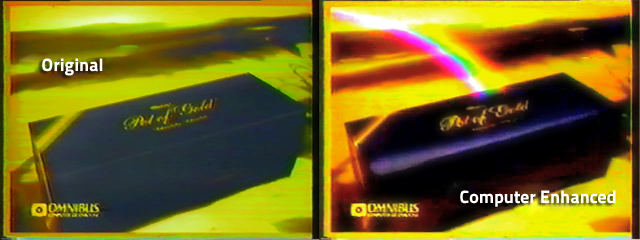My first job as a computer animator was to digitally retouch a problematic product shot. It was September, 1982. I was twenty-three and still a student, partway through the Classical Animation program at Sheridan College. Because of my drawing ability and rudimentary animations of two- and four-legged characters, I’d just been hired at Omnibus Computer Graphics in Toronto, Canada’s leading computer graphics boutique at the time. The product shot was a box of chocolates that not only required an animated rainbow but a complete adjustment of color values and edges.
I felt the disorientation of my gesture dislocated from the image.
Interestingly, I’d had a photo-retouching apprenticeship with one of my father’s colleagues, Al Pease, who was one of the top retouchers in Toronto. I struggled with lamp black and chemicals, trying to dodge and burn blemishes on black-and-white images. I practiced on matte prints, and though I could draw well enough, I had little skill with liquids and brushes.
It was a relief and an anguish to try retouching on the computer. I learned the lesson of SAVE about twenty times a day and was grateful there was a way to retain progress and undo mistakes. I was able to complete the job in a reasonable time, especially for a beginner, and especially since none of the tools had a manual explaining what they did.
Besides a steep learning curve, I felt the disorientation of my gesture dislocated from the image. I had not realized how highly trained my body had become, the loop from eye to hand wired with its own intelligence, like an extension of the brain. The skill of drawing, especially animating, resembled a performing art: practice, practice, and more practice had made drawing automatic, unconscious, smooth. Migrating this skill to a different part of my brain was incredibly frustrating, painful even. I went from expert to novice in a single day. Around me, programmers hacked away and made splendid things happen with code alone. They couldn’t draw, but could program and type—two skills in which I was sorely lacking. Using the graphics tablet was a kind of drawing, but it reminded me of trying to make a circle with the x- and y- knobs on an old Etch-a-Sketch toy.
Today I have as much speed and skill with a Wacom graphics tablet as I did with a sketch pad and pencil at the start of my career. Maybe it is like learning to type – to be swift, expert, you can never look at your hands.

Comments on this entry are closed.
hey, i never knew it was “al pease” before now! think i always had thought it was “al p’s”, like, mind your p’s and q’s. i enjoyed your writeup of the photo retouching; funnily enough, mom, dad and i were just talking about your working with al last monday! i had said, i remembered when you worked with him; you couldn’t stop talking about it/ him, must’ve made a huge and lasting impression. dad said, he was one of the best in the business in our city at the time. also re: above, appreciate the imagery of pot’o’gold. is it our irish ancestry? sure hope we find ours! no, i think we already found it, don’t you? stasia and steve